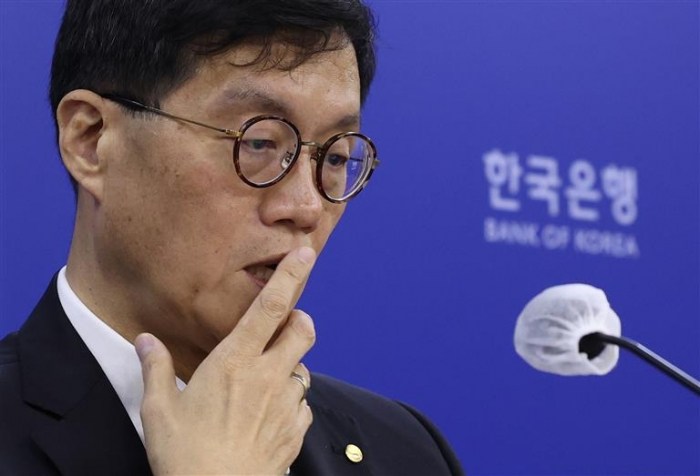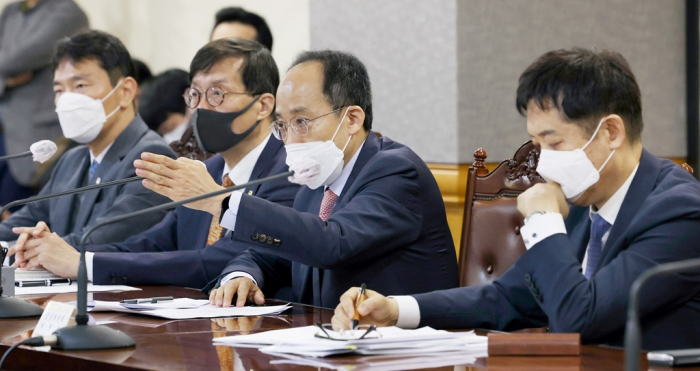Central bank
BOK chief signals another big step as Fed hike haunts won
Korea’s finance minister pledges to take FX stabilization measures 'by all means'; BOK, NPS seek currency swap to support won
By Sep 22, 2022 (Gmt+09:00)
5
Min read
Most Read
LG Chem to sell water filter business to Glenwood PE for $692 million


Kyobo Life poised to buy Japan’s SBI Group-owned savings bank


KT&G eyes overseas M&A after rejecting activist fund's offer


StockX in merger talks with Naver’s online reseller Kream


Mirae Asset to be named Korea Post’s core real estate fund operator



South Korea’s central bank on Thursday signaled another 50-basis-point policy interest rate hike as the won currency weakened past the psychologically important 1,400 per dollar level for the first time since the 2008-09 global financial crisis pressured by the US Federal Reserve’s hawkish stance after aggressive tightening.
The Bank of Korea also plans to consider a weak won and its impact on inflation as key factors for its monetary policy, its chief said.
“The precondition for a 0.25 percentage-point hike has significantly changed,” Rhee told reporters when asked if the central bank will maintain its earlier stance to raise the benchmark interest rate by 25 basis points after the Fed’s rate increase.
“The biggest change was an elevation of market expectations for the Fed’s terminal rate to a level of much higher than 4% as Fed Chair Jerome Powell mentioned,” Rhee said, referring to the peak spot where the federal funds rate is expected to climb before it is trimmed back. “The BOK had forecast the rate to be stabilized at around 4%, but the expectations significantly changed."
The US central bank on Wednesday raised its federal funds rate by 75 basis points to a range of 3.00-3.25%, higher than the BOK’s benchmark interest rate of 2.50%. Fed policymakers also signaled the intention of continuing to hike until the funds level hits terminal rates of 4.4% in 2022 and 4.6% in 2023, respectively, much higher than 3.4% and 3.8% in June.
Powell vowed to keep fighting against the rampant inflation in the US, defying investor concerns that the Fed’s sustained hawkish stance may hurt the world’s largest economy.
“The FOMC is strongly resolved to bring inflation down to 2%, and we will keep at it until the job is done,” he said in a news conference after the policy decision. US consumer prices jumped 8.3% in August from a year earlier.
KNOCKS DOWN WON
The South Korean won currency slid as much as 1.4% to 1,413.4 per dollar, its weakest level since March 31, 2009. The won was the worst performer among emerging Asian currencies with a 15.7% loss versus the greenback so far this year.
Such weakness bolstered import prices, adding to inflationary pressure in Asia’s fourth-largest economy.
The BOK will closely monitor the impact on the economy, foreign exchange market and others of the changes in conditions for monetary policy until the next meeting to decide on the timing and degree of further rate hikes, Rhee said. The BOK’s monetary policymakers are scheduled to meet on Oct. 12.
“It is an important obligation for the BOK to check the impact of the foreign exchange rate on inflation and correct it through policies,” he stressed.
Given Rhee's comments, JPMorgan Chase Bank forecast the central bank is likely to raise the base interest rate by 50 basis points next month.
“We now expect that the BOK will hike the policy rate by 50 basis points at its October meeting, preventing an 'excessively wide' policy interest rate differential with the US,” said Park Seok-gil, an analyst at JPMorgan Chase Bank in a note.
“With the expected follow-up 25bp hikes in November, January and February 2023, the BOK’s policy rate should reach a terminal rate of 3.75%.”
PLEDGE STABILIZATION MEASURES
The won is expected to weaken further as US interest rates have risen higher than those of South Korea, especially if the BOK raises borrowing costs by the usual 25 basis points, analysts said.
The Korea Economic Research Institute under the Federation of Korean Industries, a business lobby group, expected the won to soften to 1,434.2 per dollar, saying such a hike will widen the gap between year-on-year changes in benchmark interest rates of the US and South Korea by 1 percentage point.
South Korea’s foreign exchange authorities pledged to stabilize the won.
“We will actively deal with unilateral herd behavior such as increasing speculative sentiment due to the recent won’s weakness,” Finance Minister Choo Kyung-ho said in an emergency meeting before the local financial markets opened.
“We will strictly adhere to the policy of adamantly and quickly taking measures by all means when necessary.”

Bank of Korea Senior Deputy Governor Lee Seungheon also vowed to take necessary steps in the market.
“We will implement market stabilization measures in a timely manner if markets significantly grow volatile while cooperating and sharing information on financial and foreign exchange market conditions with the government,” Lee said in a separate meeting.
CURRENCY SWAP BETWEEN BOK AND NPS
The BOK is seeking a currency swap with the state-run National Pension Service (NPS) for the first time in 14 years in a move to support the ailing won, industry sources said on Wednesday.
With the swap deal, the NPS, the world’s third-largest pension fund, will be able to use dollars in the country’s foreign exchange reserves in exchange for won for overseas investments, instead of buying dollars from the currency market. The deal is also expected to help the BOK stabilize the won without hurting its reserves.
The two last did a $17.7 billion currency swap in 2005, which expired in 2008.
The fund is investing $20 billion-$30 billion in overseas assets such as stocks and bonds every year. Its overseas investments totaled 418.9 trillion won as of end-April, making up 45.6% of its total assets of 919.6 trillion won.
It has been buying spot dollars in the foreign exchange market without currency hedging for overseas investments so far, adding to pressure on the won, even policymakers pointed out.
“The NPS was procuring foreign currencies mainly in the spot market for overseas investments, which it continued to increase. That could create structural depreciation pressure,” said a member of the BOK’s Monetary Policy Board in May.
Even the US Department of Treasury cited the NPS’ overseas investments as one of the main won-weakening drivers in its bi-annual currency report released in June.
(Updated with analyst’s comments)
Write to Mi-Hyun Jo, Jun-Ho Cha, Yong-Hee Kwak and Sun Hee Chae at mwise@hankyung.com
Jongwoo Cheon edited this article.
More to Read
-

-

-
 EconomyKorea inflation slows, but BOK may still hike interest rates
EconomyKorea inflation slows, but BOK may still hike interest ratesSep 02, 2022 (Gmt+09:00)
2 Min read -
 Central bankBOK chief: S.Korea won't keep pace with Fed’s interest rate hikes
Central bankBOK chief: S.Korea won't keep pace with Fed’s interest rate hikesAug 29, 2022 (Gmt+09:00)
3 Min read -
 Central bankBOK delivers fourth straight rate hike as inflation persists
Central bankBOK delivers fourth straight rate hike as inflation persistsAug 25, 2022 (Gmt+09:00)
3 Min read
Comment 0
LOG IN


